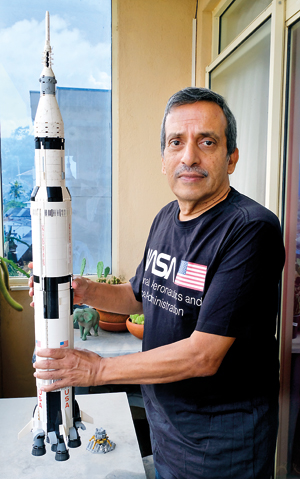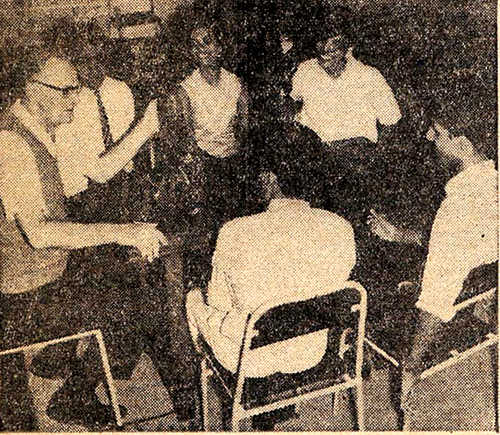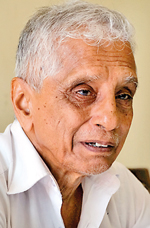Back to the moon with a roomful of memorabilia

The second man to step on the moon Buzz Aldrin sets up a solar wind experiment near the Lunar Module and (inset) The first human foot and footprint on the moon. Pix from ‘The Pictorial History of NASA’
Clustered around radios, in times long past, every crackle, every sound would be followed by intense silence so as not to miss a single word and then a burst of “oohs” and “aahs”.
Streaming over the radio were communications from a celestial body – not from ‘moon beings’ but from the very first human beings to ‘conquer’ the moon.
This day, 50 years ago, many in then Ceylon would have been deep in slumber, but for some it was a night to remember.
July 20, 1969 in the United States of America (USA) and early morn, around 1.45 on July 21, 1969 here in Sri Lanka, as the shy Mission Commander of Apollo 11, Neil Armstrong said those famous words…….“One small step for man, one giant leap for mankind.”
 It was a first – a voyage into the unknown and setting foot on an astronomical body, the only permanent natural satellite, that orbits planet earth – propelled and powered by a space race between the two most powerful nations at that time, the US and Soviet Union.
It was a first – a voyage into the unknown and setting foot on an astronomical body, the only permanent natural satellite, that orbits planet earth – propelled and powered by a space race between the two most powerful nations at that time, the US and Soviet Union.
Numerous unmanned missions had preceded this, to orbit the moon which has fascinated humans from prehistoric times. Mentioned in many mythologies, the Romans called this second brightest object in the sky after the sun, ‘Luna’, while the Greeks dubbed it ‘Selene’ and Artemis.
For Sri Lankans, the moon is very much a part of our lives…..children raise their eyes when hearing tales of the “hare on the moon” and adults lustily sing ‘Handa Mama’.

Dr. Kavan Ratnatunga’s Lego-built replica of the Apollo 11 rocket and the tiny Lunar Module. Pic by Amila Gamage
As July 20, 1969 drew nigh, for a large number of Sri Lankans, even though it was an awe-inspiring event it was happening far away, but someone we spoke to coincidentally on the morn of the full-moon this week, was in the “thick” of it right here.
Astrophysicist Dr. Kavan Ratnatunga was just 16 years old when man landed on the moon.
Seated amidst moon-landing memorabilia which includes all the yellowed and frayed news clippings of this event and a large number of books with detailed sketches and stamps issued in honour of it, he points to a model of Apollo 11’s Saturn 5 rocket that he and wife Lidwina have painstakingly and meticulously “built” of Lego.
The Apollo 11 rocket has been made to the scale of 1:110 and has 1969 pieces in commemoration of the year that man walked on the moon.
Among the books are ‘From the Earth to the Moon’ written back in 1865 by Jules Verne and interestingly ‘Destination Moon’, the adventures of Tin Tin, which Dr. Ratnatunga laughs he had “from my boyhood” published in French in 1954 and in English in 1959.
There is also ‘Interplanetary Flight’ authored by British science fiction writer, science writer and futurist Sir Arthur Charles Clarke in 1950, long before the moon landing. Clarke who made Sri Lanka his second home in 1956 would globe-trot for six months but be here for six months of the year.
Even as a little boy, Dr. Ratnatunga had had a fascination for all that was linked to astronomy, the scientific study of celestial bodies. Later, as a schoolboy, he would hold the post of Secretary of the Royal College Astronomy Society graduating to be a member of the Ceylon Astronomical Society launched by Clarke himself in 1959, 10 years before the moon landing.
Later Dr. Ratnatunga worked at the Goddard Space Flight Center of NASA (National Aeronautics and Space Administration), an independent agency of the US Federal Government responsible for the civilian space programme.
Clarke was a “powerful force”, in Dr. Ratnatunga’s words, in motivating Sri Lankans towards astronomy.

First day cover issued here to mark 20 years of the moon landing
In an era sans television, Clarke who travelled to the US for every space launch would come back and regale a wide-eyed audience at the Lincoln Auditorium of the USIS which was located in the AA Building at Galle Face, about his experiences.
“We met every month and the USIS showed video footage on the space launches and Arthur C. Clarke explained all the details,” recalls Dr. Ratnatunga.
This was the first glimpse into the unknown beyond the earth that Sri Lankans had, other countries watched the unfolding of these events live on TV.
There is a yellowed news report along with a sepia-toned photograph of Arthur C. Clarke amidst a group of “youngsters chosen from leading Colombo schools” in Studio One of the Ceylon Broadcasting Corporation (CBC) at a programme in the first of a series titled ‘Operation Space’ in the run-up to the moon landing. It had included discussions, talks, features and quizzes in all language services of English, Sinhala and Tamil every week.

Space talks with Arthur C. Clarke: Schoolboy Kavan is in the group
“The first of these features was recorded by CBC with Clarke presiding. Mr. Clarke has just returned to Ceylon from Cape Kennedy where he was till the last ‘moon shot’,” reported the Daily News.
Among those youngsters who were part of the programme was Kavan.
Dr. Ratnatunga shows off pages and pages of Sri Lanka’s coverage of the moon-landing. Extensive it was to say the least – full front pages, supplements, editorials going to great lengths to explain in detail, along with photographs.
Did you know that well-known journalist Walter Cronkite and Arthur C. Clarke were commentating for CBS, a broadcasting company, on the countdown to the moon landing, he asks.
Giving the backdrop, Dr. Ratnatunga explains that as the moon race between the Americans and Soviets intensified, NASA was created in 1958 and given an “open cheque”. There were no limits – the only condition being “just do it” by then President John F. Kennedy.
“Earlier, the issue had been funding but all that changed. If there was just 3% chance of success, funding in abundance was made available, while in the 1990s it had to be 30%. So in the 1960s any mad ideas could be tried out and that’s how there were technological breakthroughs. Today we see the natural progression of those breakthroughs made in the 1960s,” he says.
Dr. Ratnatunga sums up the Apollo missions, saying that there were 17 of which six landed on the moon and 12 men walked on the moon.

Brigadier Bandusiri Munasinghe
Next we get a lesson on the three stages of a moon mission. “See the size of the rocket and what actually lands on the moon,” he says indicating the Lego creation.
Across the road from Dr. Ratnatunga’s home lives Brigadier Bandusiri Munasinghe who was about 30 years old in 1969. “Yes, yes. I remember the moon landing,” he reminisces, adding that it was a much publicized event in Sri Lanka.
He had just returned from America bringing back with him a radio and “it was in the dead of the night” that he listened intently as the first lunarnauts to walk on the moon Neil Armstrong and Buzz Aldrin made history.
In the excitement, he shook awake his wife who was fast asleep, who just opened her eyes and said “aah” and went right back to sleep.
“It was a unique happening, something new and everybody was excited,” he adds.
These are the same sentiments expressed by many others, who had collected scrapbooks of clippings of this once-in-a-lifetime event.
| Moon landing: Ball-by-ball account | |
Here is a ball-by-ball account from ‘The Pictorial History of NASA’ edited by Bill Yenne of the moon landing as well as what preceded and what followed.
|
| From the newspapers | |
|


